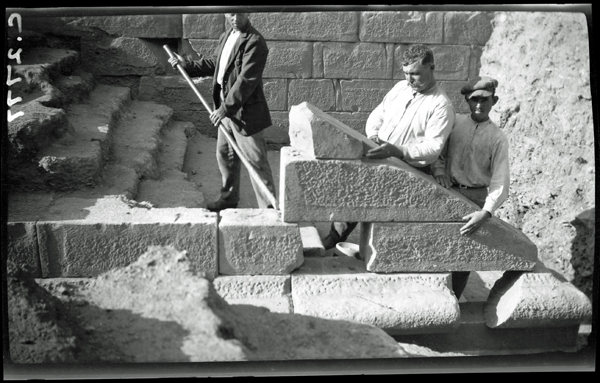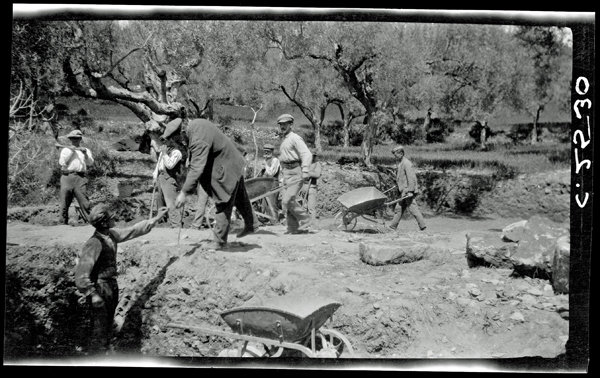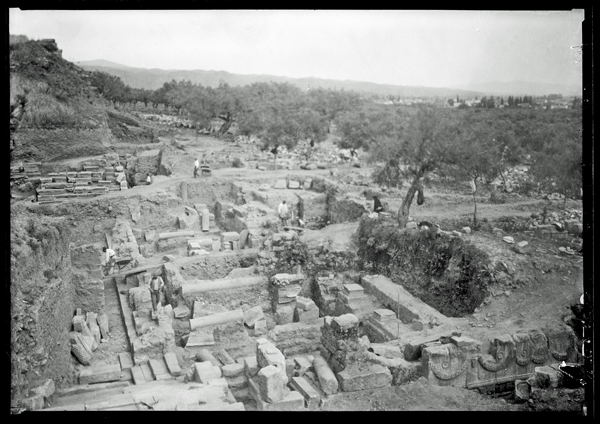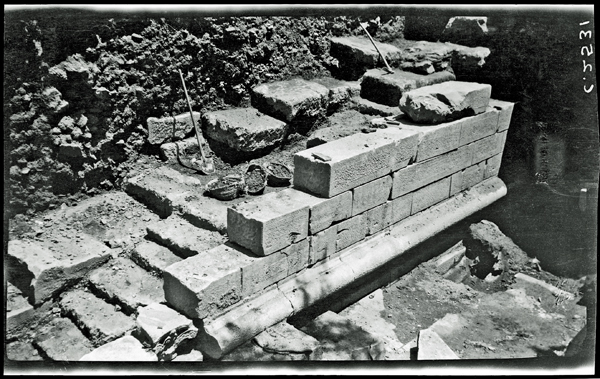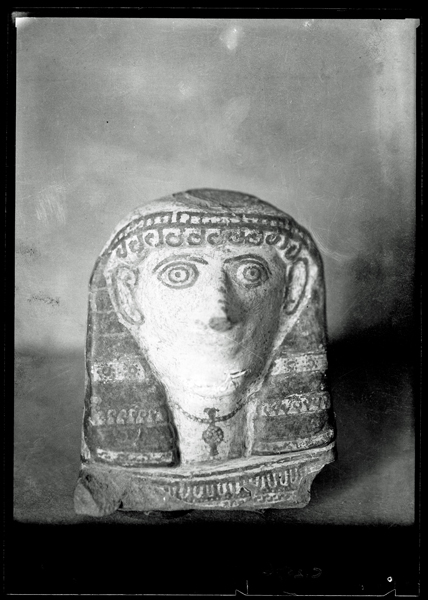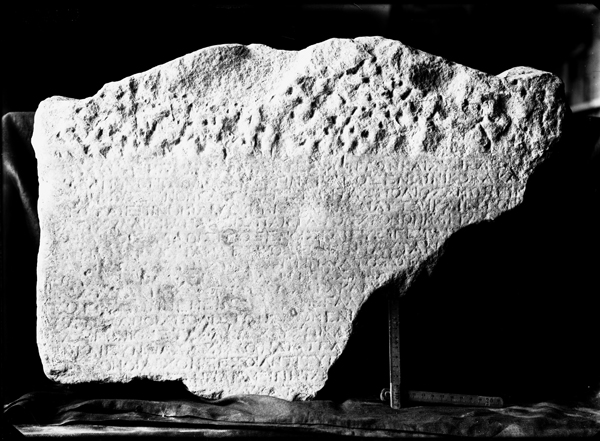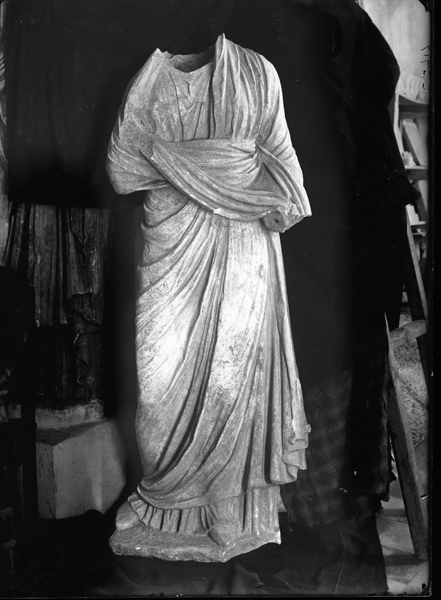Return to Sparta: the 1924-1927 BSA Excavations at Sparta in the SPHS Collection
Building on the success of the British School at Athens (BSA) excavations at Sparta in 1906-1910, the BSA returned to Sparta after WWI. The decision was made sometime during the 1922/1923 academic session, as reported in the Annual Report in the Annual of the British School at Athens (ABSA):
After considering several possible sites for excavation for next session, the Committee finally came to the conclusion that they could not do better than return to Sparta, where the School before the war made such sensational discoveries.
It was also during that session that the Assistant Director of the BSA, Arthur Woodward, who had worked at Sparta with R.M. Dawkins from 1908-1910, travelled to Sparta to examine the site for future excavation.
In 2003, a portion of the SPHS photographic collection came to the BSA, selected primarily for their link to the BSA. There are a total of 451 extant photographic records for this excavation, all of which were originally donated to the SPHS by the BSA. The collection can be broken down into the following categories: 295 images (negatives, slides, index cards), 18 duplicates in large print format collected by the BSA at an earlier time, and 138 additional index cards (primarily duplicate images) that were part of the BSA Sparta Theatre Collection of Waywell & Wilkes (from the excavations of the theatre 1992-1998) that came to the BSA in 2019. G.B. Waywell and J.J. Wilkes apparently acquired the index cards for their re-excavation of the Sparta theatre in the 1990s. The index cards had once been part of the cataloguing system of the SPHS photographic collection, but by the 1990s the collection had ceased to be functional and it is likely that the collection was in the process of being disseminated.
Work began in 1924 at Sparta, led by Woodward who had by this time become Director of the BSA. One of the major differences from the earlier excavations at Sparta was the participation of women students of the BSA, including Miss Winifred Lamb and Miss Margaret Hobling. The architect Piet de Jong was also part of the team and produced caricatures of many of the Sparta excavators, featured – along with short biographies – in Rachel Hood’s book, Faces of Archaeology in Greece. Hood quotes a letter written by Winifred Lamb to her mother in which she describes the 1924 Sparta excavation group as “an extraordinary jolly, young and refreshing party”.
Other than composition of personnel, the major difference between 1906-1910 and 1924-1927 was the main focus of excavation. Woodward chose to concentrate on the ancient theatre. The area had been investigated in the 1906-1910 excavations, but, according to the excavation reports at the time, they yielded nothing of significant interest. During the 1920s, they also conducted extensive work on the Acropolis, particularly at the Sanctuary of Athena Chalkioikos under the supervision of Miss Hobling, assisted by Miss Lamb. The sanctuary had also been briefly explored in 1906-1910. An important early Byzantine church (Hagios Nikon) had also been discovered on the Acropolis. Other areas explored included a bath-building with a mosaic pavement, an extensive Roman villa, evidence for residential and commercial areas (i.e. a portico). In the last season, a Nymphaeum was uncovered on the outside of the west retaining wall of the theatre’s stage.
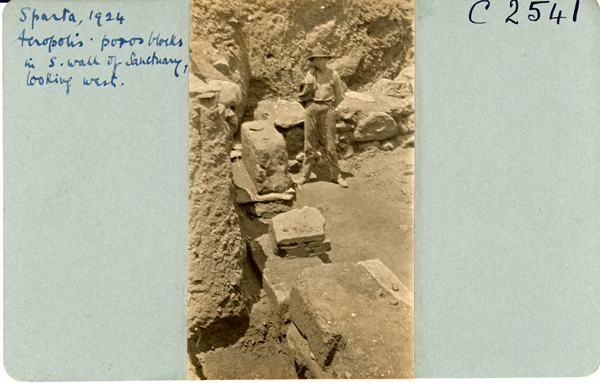
BSA SPHS 02/1/7421.C2541. Sparta: poros blocks in the S. wall of the Sanctuary of Athena Chalkioikos
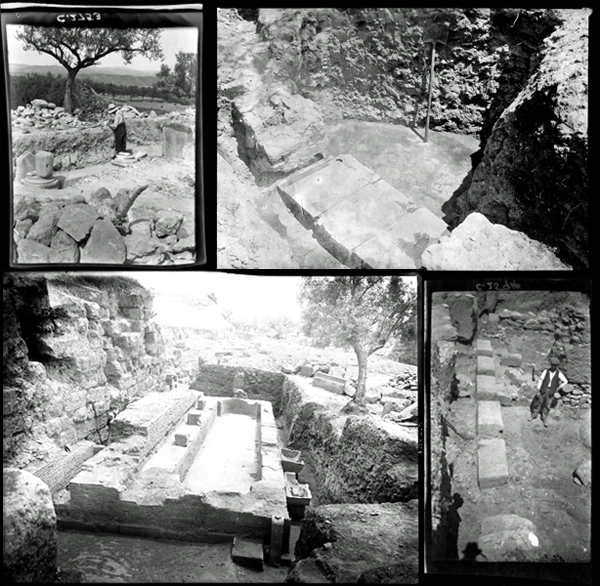
Top: Left: BSA SPHS 01/7581.C2753. Sparta: N. stylobate of the nave of St. Nikon Basilica on the Acropolis, with two column bases, looking N.E.; Right: BSA SPHS 02/1/8209.C2585. Sparta: threshold and part of mosaic pavements in Roman Baths near the Theatre
Bottom. Left: BSA SPHS 01/7629.C2801. Sparta: Nymphaeum constructed along the W. wall of the retaining wall of the theatre, looking E.; Right: BSA SPHS 01/7472.C2594. Sparta: Clearing bases of colonnade of the portico of the Archaic stoa, looking W.
The theatre had been constructed into the side of the Acropolis hill. The stage, orchestra and part of the cavea with evidence of a diazoma were exposed by the end of the first two seasons, much of which was under Byzantine strata from the later city. Massive retaining walls (the east and west parodos walls) covered in inscriptions, and staircases were also explored. Evidence from inscriptions and coins indicated that the theatre in its latest stages dated to Imperial Roman times, but also suggested that there was an earlier theatre in the same location. Work continued on the theatre up to and including the final season in 1927 by which time many fallen blocks had been restored.
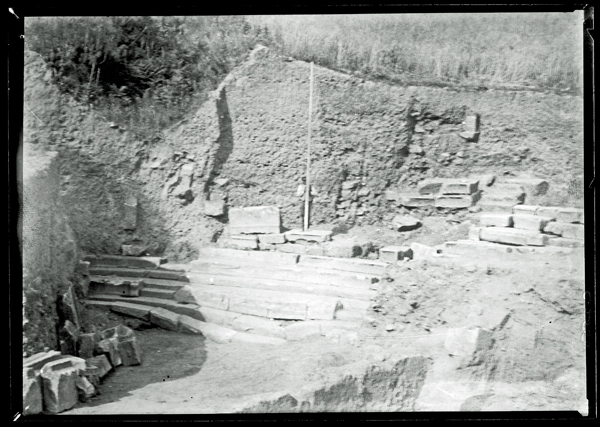
BSA SPHS 01/7433.C2555. Sparta: S.E. angle of the theatre’s cleared cavea with part of the orchestra
The finds ranged widely in time period – from Archaic to Byzantine. Many Archaic and Classical objects were found on the acropolis, many related to the Sanctuary of Athena Chalkioikos – terracottas, bronzes, decorated and inscribed pottery, etc. Fragments of a single large sculpture – torso and head, a piece of crest from a helmet, and bits and pieces of legs and feet – were also found on the acropolis, identified as a warrior, the so-called ‘Leonidas’. A plaster cast showing a reconstruction of the torso and helmeted head was created later and displayed in the 1936 exhibition in London that highlighted the first 50 years of work of the BSA. Finds in the theatre included numerous inscriptions, including several Hellenistic decrees, Roman and Byzantine objects. In the various preliminary reports that appeared in the Annual of the British School at Athens (ABSA), various classes of material were published: the bronzes (W. Lamb), terracottas, pottery (J.P. Droop), terracottas and relief ware (M. Holbing) and inscriptions (A.M. Woodward).
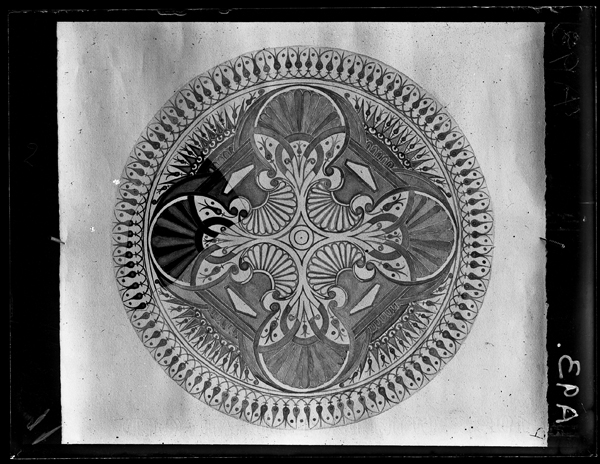
BSA SPHS 01/0027.A93. Sparta Acropolis: Restored Laconian IV (6th century) plate with an elaborate palmette design
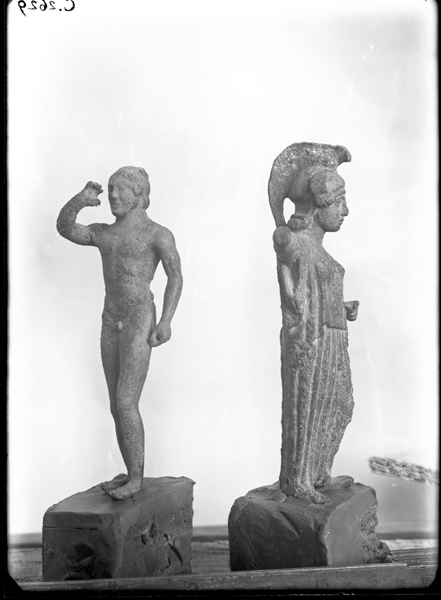
BSA SPHS 01/7487.C2629. Sparta: Bronze figures of armed Aphrodite (5th century) and Trumpeter statues from the Temple of Athena Chalkioikos
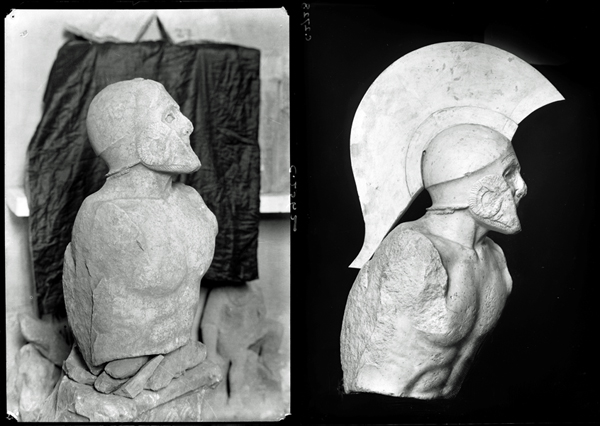
Left: BSA SPHS 01/7440.C2562. Sparta: head and torso of a 5th century warrior from the Acropolis, in profile and Right: BSA SPHS 01/7561.C2728. Sparta: Cast of ‘Leonidas’ statue with crest, original fragments found on the Acropolis, side view
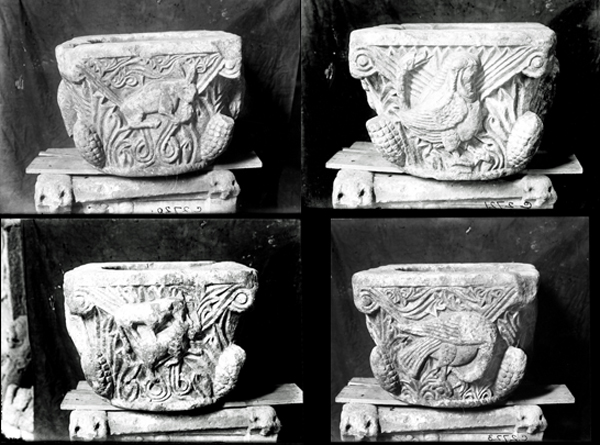
Four sides of a Byzantine column capital used as a basin found in the Theatre (top to bottom, left to right): BSA SPHS 01/7553.C2720, BSA SPHS 01/7554.C2721, BSA SPHS 01/7555.C2722 and BSA SPHS 01/7556.C2723
After the conclusion of the excavations, Woodward produced two reports, published in the ABSA. The first provided a detailed catalogue of the theatre’s architectural elements and its construction, and second, a catalogue of the inscriptions – Woodward’s specialty – found at the site. The theatre has remained the focus of further BSA work through the decades following the Woodward excavations. It was excavated by G.B Waywell and J.J. Wilkes from 1992 to 1998 under a BSA permit. The Waywell/Wilkes excavation focused on a detailed stratigraphy and development of the ancient theatre, and pushed back the date of the basic design to the Hellenistic period. More recently, BSA attention has turned to conservation – particularly preserving the Byzantine strata over part of the cavea – and preparing the site for eventual public presentation.
Deborah Harlan
British School at Athens
Images from the BSA-SPHS collection are available on the BSA’s Digital Collections page.
Three Archive Stories about two decades of BSA activity in Laconia and Sparta:
Sparta Groundwork: SPHS images of Early BSA Explorations in Laconia
Sparta Begins: 1906-1910 BSA Sparta Excavations in the SPHS Collection
Return to Sparta: 1924-1927 BSA Excavations at Sparta in the SPHS Collection
Click here for more BSA Archive Stories.
Further Reading
Hood, R. 1998. Faces of Archaeology in Greece: Caricatures by Piet de Jong. London: Leopard’s Head Press.
Waywell, G.B. and Wilkes, J.J. 1995. ‘Excavations at the Ancient Theatre of Sparta 1992-4: Preliminary Report’, Annual of the British School at Athens, 90: 435–460.
Woodward, A.M. and Hobling, M.B. 1923/1924. ‘Excavations at Sparta, 1924-25’, Annual of the British School at Athens, 26: 116–310.
Woodward, A.M. 1925/1926. ‘Excavations at Sparta, 1926’, Annual of the British School at Athens, 27: 173–254.
Woodward, A.M., Droop, J.P. and Lamb, W. 1926/1927. ‘Excavations at Sparta, 1927’, Annual of the British School at Athens, 28: 1–106.
Woodward, A.M., Robert, L. and Woodward, J.M. 1927/1928. ‘Excavations at Sparta, 1924-28’, Annual of the British School at Athens, 29: 1–107.
Woodward, A.M. 1928/1929. ‘Excavations at Sparta, 1924-28: I. The Theatre: Architectural Remains’, Annual of the British School at Athens, 30: 151–240.
Woodward, A.M. 1928/1929. ‘Excavations at Sparta, 1924-27: II. Votive Inscriptions from the Acropolis’, Annual of the British School at Athens, 30: 241–254.
